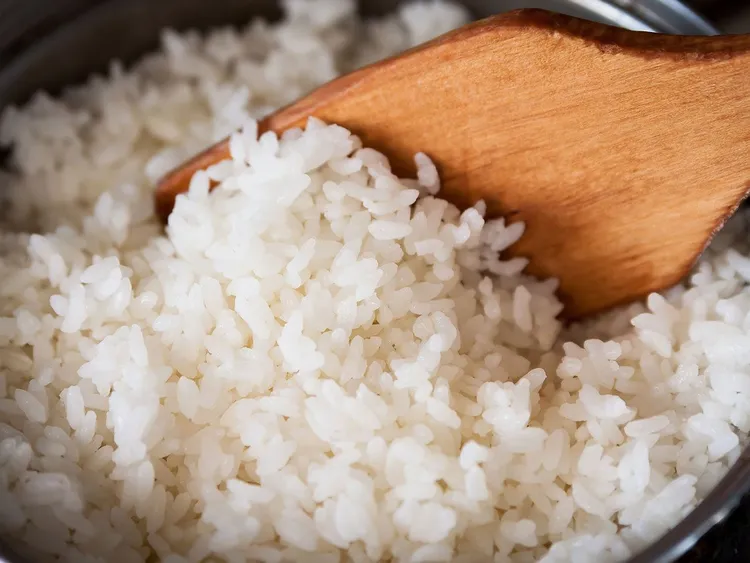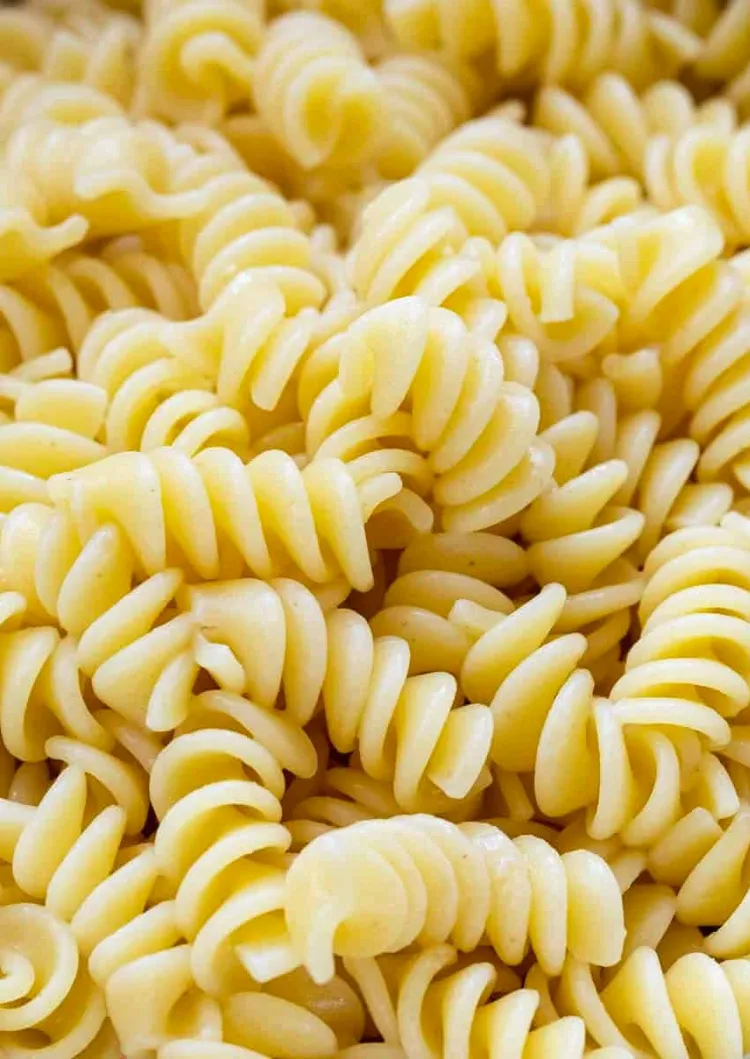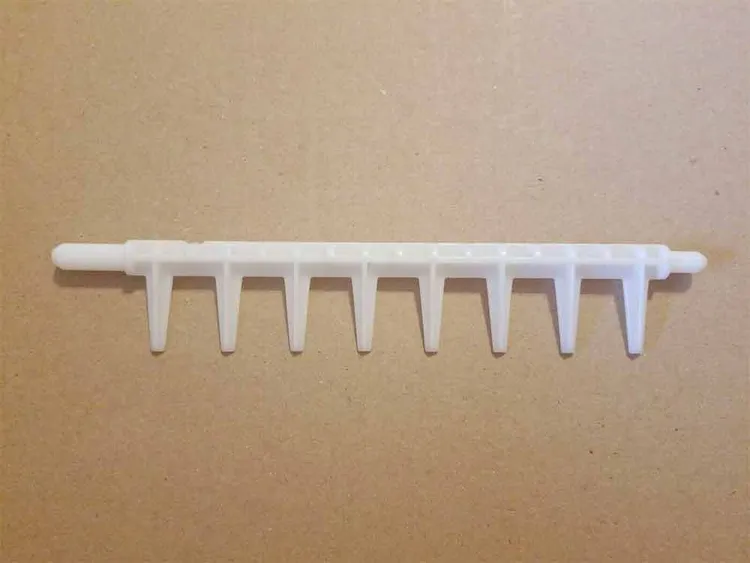Our recommendations are made independently through Research & Testing. We may receive commissions from purchases made via our links.
How to Freeze Tomatoes
Have some fresh tomatoes? Here’s a guide on how to freeze tomatoes to help you keep them through the winter months.
One of the most useful things you can know how to do in the kitchen is how to freeze tomatoes. As a food ingredient, tomatoes are highly versatile. You can put a few slices into a salad to make the dish look more appealing with their vibrant colors. Tomatoes are also rich in Vitamin C and Potassium, so they would also give your plate a nutritional boost.
They can be eaten raw, juiced or sculpted into garnishes, among dozens of other uses.
The issue is that tomatoes are only in season from May through October. If you want to enjoy summer-ripened tomatoes during the winter months, you must know how to preserve them.
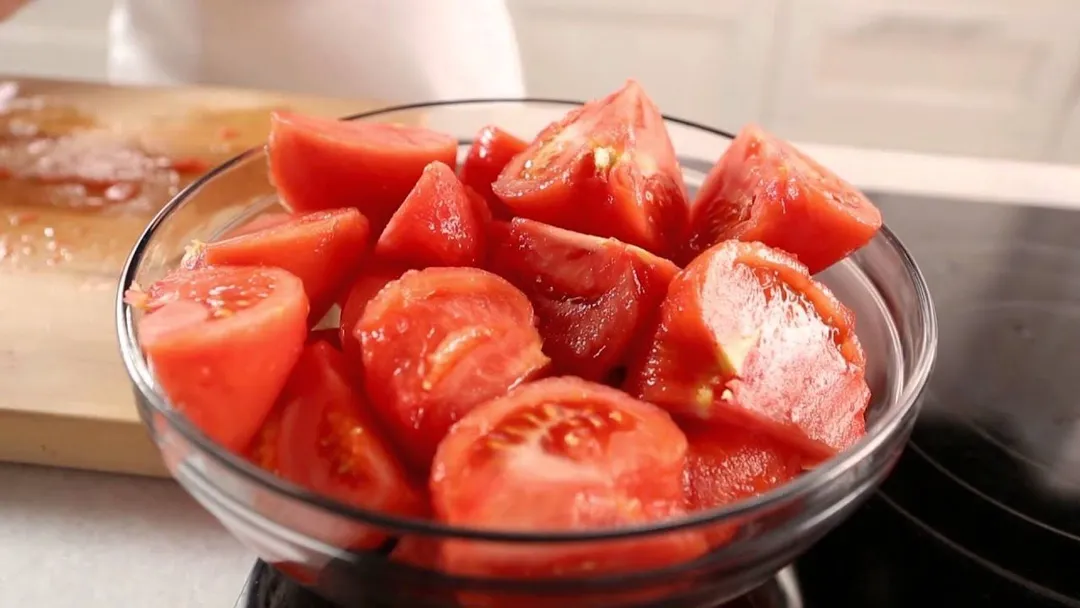
So here’s a guide that can teach you exactly that.
Can You Freeze Tomatoes?
Yes, tomatoes can be safely frozen.
Not only that, tomatoes are also significantly easier to preserve than other foods and fruit. This is because tomatoes do not need to be blanched before they are frozen.
Additionally, the outer skin of the tomatoes isn’t an obstacle to the freezing process. If you don’t have the time to peel your tomatoes, they can be frozen without being peeled.
In fact, freezing without peeling first is our recommended method. There aren’t many advantages (if any at all) to peeling the tomatoes before freezing. When you finally thaw your frozen tomatoes down the line, the tomatoes would turn soft once they reach room temperature. The softness makes sloughing off the skin quick and easy.
Properly frozen and stored, tomatoes (including variants like cherry tomatoes) can last up to six months.

1. Can You Freeze Cherry Tomatoes?
Cherry tomatoes are one of the most popular crops grown in home gardens. They are resilient, fast-growing, and each plant can produce multiple clusters while in season (all through the summer months).
Furthermore, you can freeze cherry tomatoes without removing the core, so the freezing steps are as straightforward as can be.
2. Can You Freeze Green Tomatoes?
Although green tomatoes aren’t nearly as popular as their hot-red, ripened variant, they are completely safe to eat.
If you want to preserve cherry tomato clusters well into winter, you can. Just freeze them like ordinary tomatoes. Similar to their full-sized counterparts, cherry tomatoes can be frozen without blanching.
They are just as rich in vitamins, fiber, and other essential minerals as ripe tomatoes. Moreover, recent research has shown that green tomatoes contain more tomatidine, which can help combat muscle atrophy and aid with weight loss.
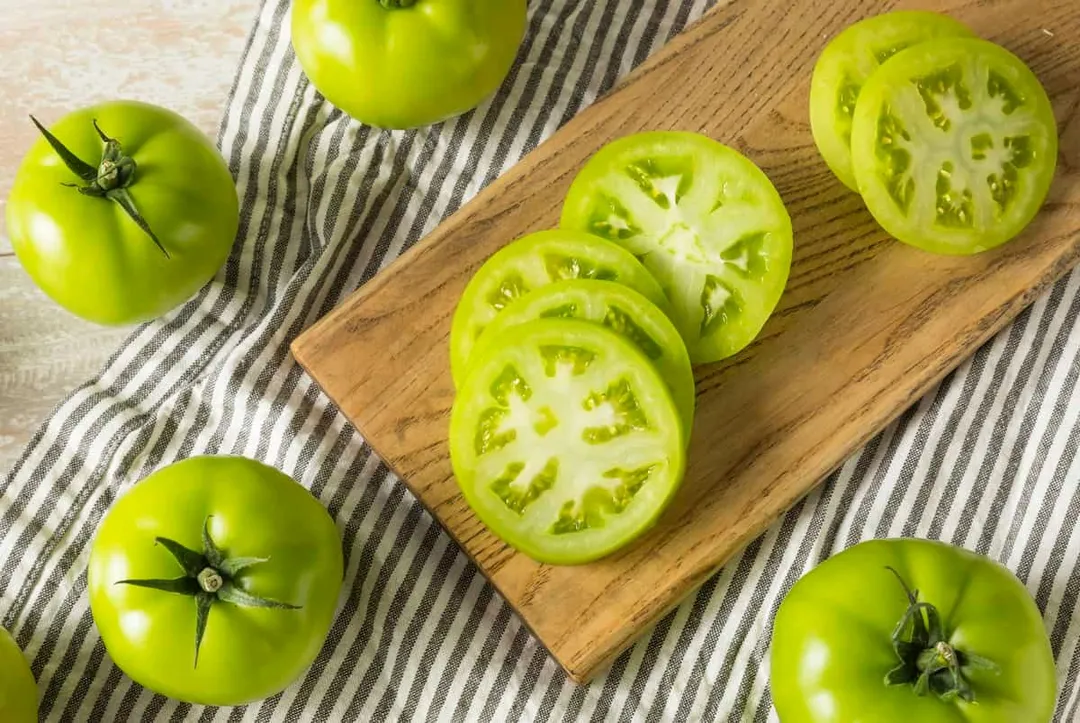
However, because they haven’t gone through the ripening process to produce more sugar, green tomatoes taste quite tart and acidic. This can be a turn-off for a lot of people. Still, it’s highly recommended that you add some to your diet.
Dieting isn’t the only reason people want to freeze green tomatoes, though.
For those who grow tomatoes at home, you probably already know how bad cold is for the crops. If they haven’t reached maturity by the time the cold sets in, it’s best to harvest and freeze them. Even if you dislike green tomatoes, having them in the freezer is better than having nothing at all.
3. What Kind of Tomato to Freeze
Sub-par or spoiled tomatoes are going to taste even more terrible down the line once they are thawed. So avoid freezing them and discard them, instead.
Any variant of tomato can be frozen, so whatever you have in your pantry or your garden will do. Just make sure that they have the right color and firmness.
But you should also plan out what you’re going to do with the tomatoes later on, especially if you’ve purchased them rather than grown them.
If you want to use them to prepare special recipes like stuffed tomatoes, you will need to be picky about the variant. There are tomato variants engineered to be hollow on the inside to make stuffing easier. Their names usually contain either “Hollow” or “Stuffer”, such as Yellow Stuffer or Schimmeig Striped Hollow.
They may be a bit difficult to get your hands on, but if you can, they are much easier to prepare.
The Best Ways to Freeze Tomatoes
The best way to freeze tomatoes is to freeze them unpeeled. Like we mentioned earlier, it’s just quicker and more convenient. But just in case, we will also tell you how you can freeze peeled tomatoes, as well.
Freezing other variants like cherry and green tomatoes isn’t all that different from freezing your ordinary full-size, ripe tomatoes. The processes will just have a couple small modifications here and there.
1. Whole Tomatoes
Note that this process will work for both green and red tomatoes.
Freezing Without Peeling
Wash the tomatoes using cold tap water.
Gently rub the tomatoes while they’re under the tap to brush away all the dirt.
If you’re worried about pesticide residue, soak for 15 to 20 minutes in a solution of baking soda and water. Mix 1 ounce of baking soda for every 100 ounces of water.
With a towel, dry the tomatoes. If they’re wet when put in the freezer, frost can form on the skin.
Slice the stem scar (or “leaf scar”) from the top of the tomatoes. Just use a knife to cut off the top ¼ of the tomatoes. No need to core out the tomatoes if you want to freeze them whole.
Place the tomatoes onto a baking sheet. Ensure that there is plenty of space between them. Ideally, they should not touch one another while they are on the sheet.
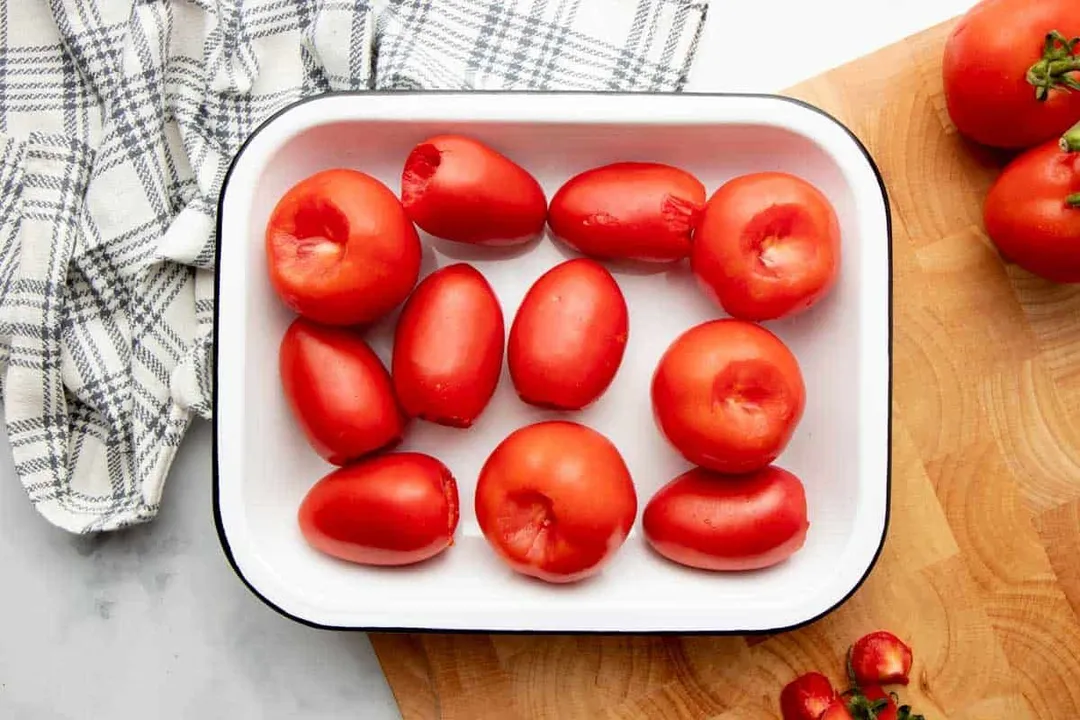
If you have a lot of tomatoes to freeze, you should separate them into batches and freeze them separately. Crowding the sheet is going to decrease the freezing efficiency.
Let them freeze for about 4 to 5 hours.
When they are fully frozen (the tomatoes should feel solid when gently squeezed), transfer them into resealable plastic bags. Label the bags carefully, write out what they are and the date frozen. The labels will help you to keep track of them more easily.
Seal the bags tightly and squeeze out excess air. Then place the bags back into the freezer for long-term storage.
Freezing Peeled Tomatoes
If you want to peel your tomatoes before freezing, boiling will make it easier to deskin the tomatoes by hand.
Prepare and wash the tomatoes as before, then cut off the stem scar.
Boil up a vat of water and dip the tomatoes in.
Watch the tomatoes carefully. Once the skin begins to split, fish them out of the water immediately using a netted spoon. It should take each tomato 1 minute in the water for the skin to begin splitting.
The split skin will be easier to slough off.
Once the tomatoes are peeled, arrange them onto a baking sheet and freeze for 4 to 5 hours. When fully frozen, pack them into resealable plastic bags, label, and put away in a freezer for storage.
2. Cherry Tomatoes
Just like with whole tomatoes, choose ripe and undamaged cherry tomatoes for freezing. Discard any with visible blemishes or spoilage.
If your tomatoes are still attached to their stems, remove them from the stems.
Wash the individual cherry tomatoes using cold water and drain using a colander. Dry with a towel to prevent frost from forming during the freezing stage.
Place the cherry tomatoes onto a baking sheet. Just like whole tomatoes, leave plenty of space between each of them. If they’re frozen while touching one another, they can stick together and form into clumps.
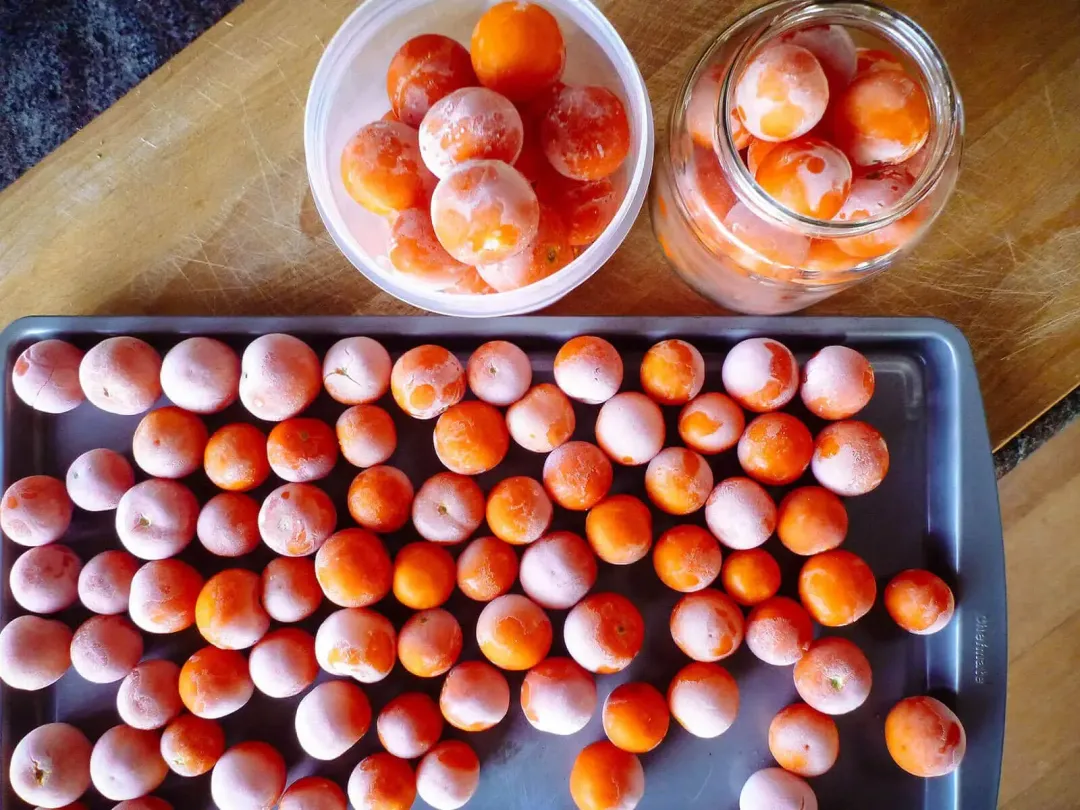
Freeze for 4 to 5 hours. Put into resealable plastic bags once frozen, label carefully, and place back into the freezer for storage.
3. Dry Tomatoes
Freeze drying is an alternative to conventional freezing with the freezer. Foods that have been freeze dried last significantly longer than those that are frozen normally. Typically, their shelf-lives are counted in years rather than months.
Use this method if you plan to store the tomatoes for long-term use.
Freeze drying will typically require a special freeze dryer, which we highly recommend you get if you’re serious about freeze drying. But if this is a one-off thing, you can also freeze dry tomatoes with dry ice.
What Is Dry Ice & What Precautions Should Be Taken?
Dry ice is basically solid carbon dioxide. The first advantage to dry ice is that it is very cold (-109°F). The cold temperature is going to freeze your tomatoes in seconds.
The second advantage is that dry ice sublimates. Instead of becoming a liquid when it warms up, it turns into gas. The sublimation process also sucks moisture from the surrounding environment. So if you place your tomatoes near dry ice as it sublimates, it is also going to dry out your tomatoes.
Dry ice’s extremely low temperature coupled with its ability to suck moisture makes it an excellent freeze drying material.
Be very careful while using it.
Wear protective gloves at all times while handling dry ice to protect yourself from cold burns. Additionally, the gaseous form of dry ice — CO2 — can cause poisoning and asphyxiation. Only freeze dry with dry ice in a room that is well-ventilated.
If your house has children, make sure they never enter the room.
If you feel light-headed or nauseous while in the room with sublimating dry ice, leave the room immediately. These are symptoms of CO2 poisoning.
How to Freeze Dry Tomatoes With Dry Ice
Put your tomatoes into freezer-safe resealable plastic bags. Then, place them in a large cooler that is rated to work with dry ice.
Make sure not to close the lid of the cooler while dry ice is still fuming inside. If you close the lid, pressure can build inside the cooler and cause it to explode.
Bury the bags in a thick layer of dry ice.
Wait for around 12 to 24 hours until all of the dry ice has sublimated.
Remove the bags from the cooler, label, and store in a freezer.
Conclusion
Learning how to freeze tomatoes is quite simple, isn’t it? There aren’t many steps and most of them are straightforward. We hope this guide has been helpful to you.
Authors
Luna Regina is an accomplished writer and author who dedicates her career to empowering home cooks and making cooking effortless for everyone. She is the founder of HealthyKitchen101.com and HealthyRecipes101.com, where she works with her team to develop easy, nutritious recipes and help aspiring cooks choose the right kitchen appliances.

